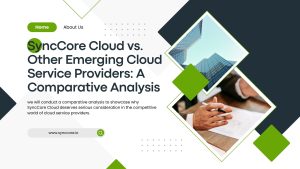Table of Contents
Introduction to Monitoring as a Service in Cloud Computing
As the technological world expands rapidly with new technologies and new possibilities, these are the security concerns and preventive measures to ensure seamless service delivery. Everything in today’s world could be provided as a service, such as PaaS (Platform as a service), SaaS (Software as a service), and so on. It can now be provided as a service by combining several tools.
MaaS protects technology assets from cyber threats, ensuring continuous and functional service delivery. It is a service that can be used flexibly and cost-effectively. “MaaS” has gained prominence with its expansion.
What is the difference between traditional Security and MaaS?
The significant difference between them is:
⦁ When compared to traditional security and monitoring operations, MaaS is exceptionally cost-effective.
⦁ Flexibility.
⦁ Traditional security operations have lower effectiveness than MaaS.
What are its features of it?
The top 3 features of Monitoring as a Service are listed below:
⦁ Prevention against threats
⦁ Real-time
⦁ Better delivery
Prevention Against Threats
They analyze the alerts in real-time and provide logs 24 hours a day, seven days a week. Security operations teams collect and analyze data to identify potential threats and vulnerabilities and then apply preventive measures or resolve the problem. Its advantages are as follows:
⦁ Detection as early as possible
⦁ Better GUI/Dashboard support
⦁ Centralized logs
⦁ Continuous updates and upgrades
Real-time Monitoring
The documentation of data/logs assists developers and operations/monitoring teams in understanding the issue and where it may be located, either on the system or on the application side. Its crucial feature is faster detection and resolution of errors/threats.
MaaS alleviates many time-consuming issues.
Better Delivery
Building security monitoring infrastructure and a team to monitor and analyze logs cost more regarding return on investment. As a result, most businesses outsource this service to save money. These vendors have complete information about them and highly skilled teams that are up to date on the latest technological trends.
What are the types of it?
MaaS is divided into several regions, the most important of which are:
Cloud Monitoring as a Service
The cloud is a volatile technology with numerous components that make monitoring difficult. It can be defined as the collection, management, and analysis of logs and data. Management provides a real-time availability and performance review of the services and resolves issues before they arise. It contains numerous components, including:
⦁ Database
⦁ Virtual network
⦁ Cloud Storage
⦁ Websites
Database Monitoring
To run various services, the cloud relies heavily on databases. These methods examine processes, data availability, data consumption, and queries. The majority of the items could be tracked for security purposes.
Virtual Network
We can monitor network components like firewalls and load balancers. They are integrated tools designed to provide data that can be useful, such as traffic.
Cloud Storage
This method allows you to track multiple resources from multiple services and analyze them all simultaneously to check their health and issues. This technique is helpful in Infrastructure as a Code (IaaC) and possibly in Software as a Service (SaaS) (Saas). It can keep track of metrics, users, storage space availability, and so on.
Website / Application Monitoring
When we talk about Websites and Applications, these are files that are stored locally and exchange data when needed, and monitoring this flow of data aids in the improvement. It prevents any failure resulting in downtime—monitoring traffic, memory / CPU utilization, accessible storage space, and so on.
Security Monitoring as a Service
Security monitoring is based on review logs, network security testing (via traffic examination tools such as grunt, etc.), and raw data (see Physical Security above). The following are the requirements for security checking:
⦁ It will be a highly accessible and solidified assistance that is open inside or somewhat secure.
⦁ The age of alerts is based on automated recognition that a critical security event or circumstance has occurred or is recognized.
⦁ The dissemination of critical warnings via various means so that security and the board are made aware as soon as possible.
⦁ The ability of security personnel to investigate and arrange an unfolding episode or audit logs to further develop cautioning components or physically distinguish security occurrences.
⦁ Implement a cloud-wide interruption and oddity detection capability and consider communicating this as a service to residents.
Why is it essential?
Monitoring is a vital cloud security technique with several critical applications for CSPs and residents. These are some examples:
Detection of Danger Some adventures are unavoidable, and some dangers are unexpected; in this sense, checking is the last line of defense. In any case, there is a distinction between recognizing a security situation and conducting business.
Examination of Security Controls Although most security controls are designed to support security strategy; observing is used to confirm the proper operation of other security controls. If events demonstrating activities prohibited by approach appear in the security event stream, this would indicate that security controls do not accurately authorize that arrangement.
Bugs’ willingness to share Security monitoring has revealed previously unknown flaws or security blunders. This can take several structures, including activating checking rules, which essentially do not appear OK compared to the observing record.
A Legal Activity Record Security event data can create a legal record of client or cycle activities. This information must be credible in a legal proceeding (descriptions have not been changed, and they contain a total record). The association should demonstrate a chain of custody over the information.
Enhancing Forensics Security event data is extremely valuable in comprehending the means associated with an adventure and knowing the extent of any subsequent harm.
Infrastructure Monitoring as a Service
Infrastructure monitoring collects health and performance data from servers, virtual machines, hardware, data sets, and other backend components. Designers can use it to visualize, dissect, and alert on measurements and determine whether a backend issue is affecting clients.
IT professionals claim and carry out a business interaction. Its motivation is to collect and dissect information from the IT framework to develop business results further and drive esteem creation for the organization.
Engineers frequently use a framework testing stage to determine whether their backend components are causing a problem for a client. To discover why they can then investigate the corresponding asset measurements from their backend:
Computer processor Utilization:
This demonstrates a host’s handling limit to deal with processing tasks. When an application is prolonged or times out, it may indicate that the host is under-provisioned, with a low CPU to handle demands quickly and oversee other tasks.
Memory Utilization:
This displays the number of items or bytes the host has in transient capacity to run a program. When a host uses its memory, it can never again acknowledge or serve additional demands.
Capacity Use:
This demonstrates how much plate the host uses to store data, images, and other materials. When things are expected to run a program, they can be replicated from capacity to short memory. When a host runs out of plate space, you may lose information, or the hidden application may fail.
What are the Use Cases of it?
Task groups, DevOps architects, and site unwavering quality specialists (SREs) frequently rely on framework observing for assistance:
Troubleshooting
It is typically used to prevent outages from becoming blackouts. A foundation monitoring instrument can reveal which hosts, holders, or other backend components fizzled or were dormant during an episode. Designers can determine which hosts or compartments are capable when a blackout occurs. This assists groups in resolving support tickets and dealing with client-facing issues.
Optimization
It can also be used to reduce costs in advance. For example, if a portion of your servers is overprovisioned or idle, you can decommission them and run the related responsibilities on fewer resources. You can also adjust your framework utilization by directing requests from under-provisioned hosts to over-provisioned hosts.
Forecasting requirements
By reviewing previous data, businesses can forecast future resource utilization. For example, suppose specific hosts were under-provisioned during a new item dispatch. In that case, you can design more CPU and memory in the future during comparable occasions to lessen stress on critical frameworks and decrease the likelihood of income-depleting blackouts.
Conclusion
MaaS provides ready-made tools at a low cost. Customers can concentrate on their core competencies rather than worrying about IT security and management and assuring 24-hour availability and immediate resolution. Threat detection and management are being automated. Provides advanced data analysis for resource management.



